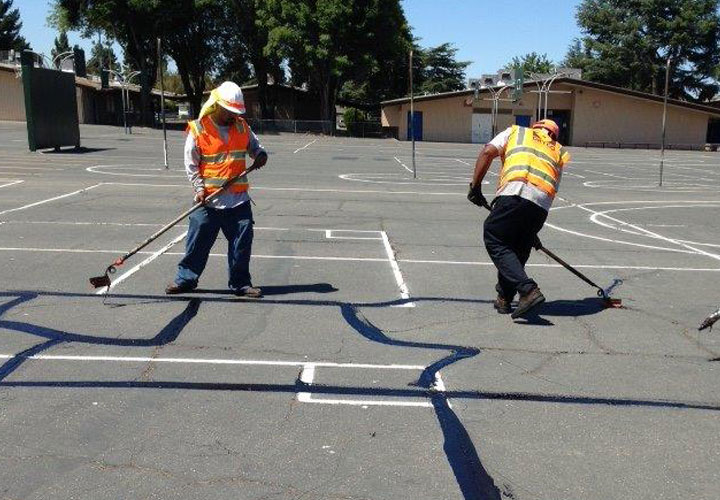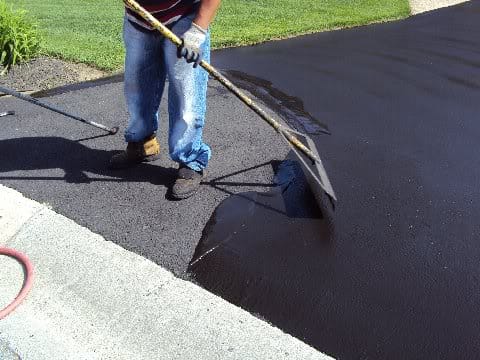Swift Solutions for Asphalt Spot Repair: Optimum Securing Strategies
Cold Mix Asphalt Vs. Hot Mix Asphalt: Which Is Right for You?

Composition Distinctions
Cold mix and hot mix asphalts differ considerably in their make-up, with distinct attributes that affect their performance and applications. Cold mix asphalt is created by emulsifying the asphalt binder with water and an emulsifying agent before mixing it with accumulation. This method permits the asphalt to be convenient at lower temperature levels, making it perfect for temporary repairs and for usage in chillier weather conditions. Hot mix asphalt, on the various other hand, is manufactured at high temperatures, typically between 300-350 ° F, which aids to attain far better compaction and an extra resilient end product. The hot mix asphalt manufacturing process involves heating the aggregate and asphalt binder separately before incorporating them at the asphalt plant.
In addition, cool mix asphalt has a tendency to be much less thick and a lot more flexible than hot mix asphalt. This adaptability makes it better matched for areas with higher levels of activity, such as driveways or roads with heavy web traffic. On the other hand, warm mix asphalt is recognized for its high sturdiness and resistance to rutting and fracturing, making it a recommended selection for highways and high-traffic roadways where durability is important.
Setup Process Variances
The process of setting up cold mix and hot mix asphalt exhibits significant differences in their needs and treatments. In comparison, warm mix asphalt necessitates an extra elaborate installment procedure. Due to the heating requirements, hot mix asphalt setups are commonly lugged out by experts with specific tools, ensuring an extra structurally sound and long-term result.
Toughness and Long Life Variables
When considering asphalt choices, sturdiness and durability are important aspects to assess for enduring pavement performance,. Warm mix asphalt (HMA) is understood for its remarkable resilience and long life. The heats throughout the mixing and laying procedure enable for far better compaction, resulting in a denser and stronger pavement structure. This leads read what he said to HMA being much more immune to rush hour loads, rough climate condition, and the results of maturing compared to chilly mix asphalt (CMA)
In regards to longevity, HMA typically outmatches CMA due to its premium strength and resistance buildings. HMA pavements have a longer solution life, needing less constant fixings and maintenance, which can equate to set you back savings in the future. Furthermore, HMA pavements are more conveniently customizable to fulfill details task needs, better enhancing their longevity.
Expense Factors To Consider
Considering the economic ramifications is a critical facet when examining the selection between hot mix asphalt (HMA) and chilly mix asphalt (CMA) for sidewalk tasks. While the preliminary price of warm mix asphalt is generally greater than that of cold mix asphalt, HMA usually provides a more cost-efficient service over time because of its remarkable durability and longevity. HMA is known for its capability to endure rush hour lots and rough climate condition, minimizing the demand for frequent repair work and maintenance. On the other that site hand, cold mix asphalt is extra budget friendly ahead of time but may need more frequent patching and resurfacing, resulting in higher upkeep costs with time.
In addition to material prices, it's vital to take into consideration the expenditures related to setup and upkeep when comparing HMA and CMA. HMA usually requires specific tools and knowledgeable labor for appropriate setup, which can influence total task costs. On the other hand, CMA is much easier to deal with and can usually be used utilizing less complex methods, potentially decreasing setup costs. Eventually, the choice between HMA and CMA need to take into consideration not just the initial cost however likewise the lasting financial ramifications to determine the most affordable alternative for the particular pavement project.
Environmental Impact Contrast
Comparison of the ecological impacts in between hot mix asphalt (HMA) and cool mix asphalt (CMA) exposes unique differences in sustainability practices. HMA production requires high temperatures, leading to raised energy intake and greenhouse gas emissions.
In addition, the use of CMA often involves reusing existing asphalt sidewalk, promoting source preservation and decreasing the amount of waste sent out to garbage dumps. By opting for CMA over HMA, roadway building and construction tasks can add positively to ecological conservation initiatives.
Conclusion
In final thought, the choice in between chilly mix asphalt (CMA) and warm mix asphalt (HMA) depends on different variables such as structure, setup procedure, resilience, longevity, cost, and ecological effect. cold mix asphalt. While CMA offers a economical and quick solution for small repairs, HMA guarantees superior longevity and longevity for rush hour locations. Think about these factors thoroughly to figure out which type of asphalt is the right choice for your paving requires

Considering the economic implications is a critical facet when examining the selection in between warm mix asphalt (HMA) and chilly mix asphalt (CMA) for sidewalk jobs. While the initial cost of warm mix asphalt is typically greater than that of cool mix asphalt, HMA frequently gives an extra cost-efficient option in the long run due to its superior sturdiness and durability. asphalt repair.Contrast of the environmental impacts between warm mix asphalt (HMA) and chilly mix asphalt (CMA) exposes distinct differences in sustainability practices.In conclusion, the option between cool mix asphalt (CMA) and hot mix asphalt (HMA) depends on different factors such as make-up, setup process, sturdiness, longevity, expense, and ecological influence